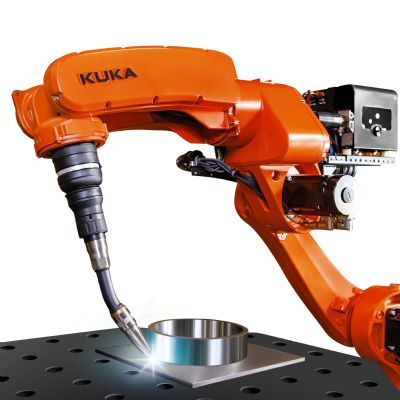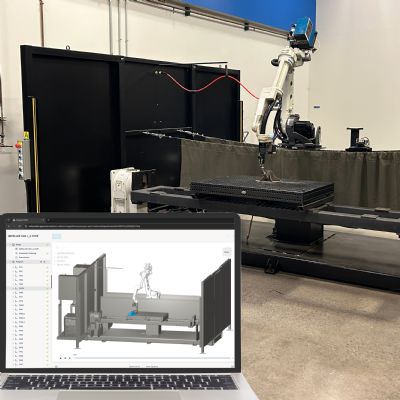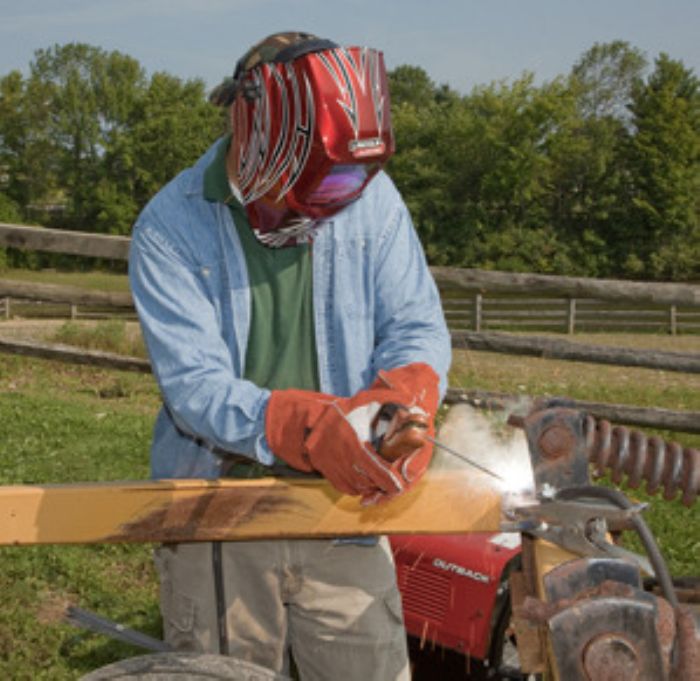 GMAW and FCAW also offer higher welding speeds due to the continuously fed electrode, absence of slag in the case of GMAW and higher filler-metal deposition rates. With an operating factor―time where the welder actually “creates sparks”―of typically 30 to 50 percent, 3 to 5 min. out of every 10 min. can be spent creating an arc.
GMAW and FCAW also offer higher welding speeds due to the continuously fed electrode, absence of slag in the case of GMAW and higher filler-metal deposition rates. With an operating factor―time where the welder actually “creates sparks”―of typically 30 to 50 percent, 3 to 5 min. out of every 10 min. can be spent creating an arc.
GMAW can be used on all of the major commercial metal alloys. FCAW currently finds use primarily on steels and stainless steels. These two processes also can be used over a wide range of material thicknesses and can operate in all welding positions.
On the downside, GMAW and FCAW equipment can be quite complex, more costly and traditionally less portable than that for SMAW, although some new portable models do exist. Welding via these processes typically occur within a 10 to 12-ft. radius of the wire feeder, with work usually brought to the weld station.
SMAW
SMAW (or stick welding) represents the most common form of arc welding. In this process, a stick or electrode is placed at the end of a holder, with electricity from the power source used to strike an arc between the tip of the electrode and the workpiece surface. The heat of the arc melts the tip of the electrode, creating the filler material that deposits as the electrode is consumed. A coating on the electrode burns and protects the arc from the atmosphere. The burning of the coating produces CO2, which becomes the shielding gas. A slag, also formed, helps refine the weld metal and protects it as it solidifies.
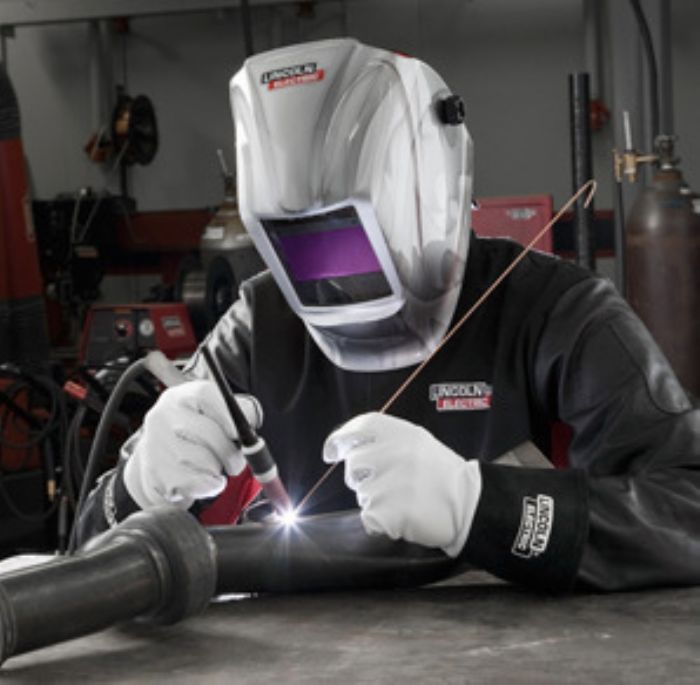 Welders consider SMAW as one of the simplest and most versatile processes because filler material can be changed easily to match different metal alloys just by switching stick electrodes. Whether steel, stainless steel, cast iron or high-alloy metals, users simply clamp in a new rod to be ready for the next project. In addition, SMAW offers versatility because it requires the least amount of equipment, thus easing setup or relocation.
Welders consider SMAW as one of the simplest and most versatile processes because filler material can be changed easily to match different metal alloys just by switching stick electrodes. Whether steel, stainless steel, cast iron or high-alloy metals, users simply clamp in a new rod to be ready for the next project. In addition, SMAW offers versatility because it requires the least amount of equipment, thus easing setup or relocation.
When compared to other types of power sources, SMAW sources generally rank as the least expensive. As a result, they most often find use by novice welders, farmers, smaller fabricating shops, maintenance shops and large field-construction contractors that weld on a variety of jobs over a large physical area.
The main disadvantage of SMAW: the amount of downtime associated with the process. An electrode only measures so many inches in length and must be changed once it is consumed, requiring the operator to stop welding. Frequently, the amount of skill required by the operator surpasses that required for wire-fed processes.
In addition, chipping or grinding the slag or impurities from the welds takes time. The operating factor typically amounts to 2 to 3 min. per 10-min. interval. In general, SMAW sacrifices productivity for versatility.
GTAW
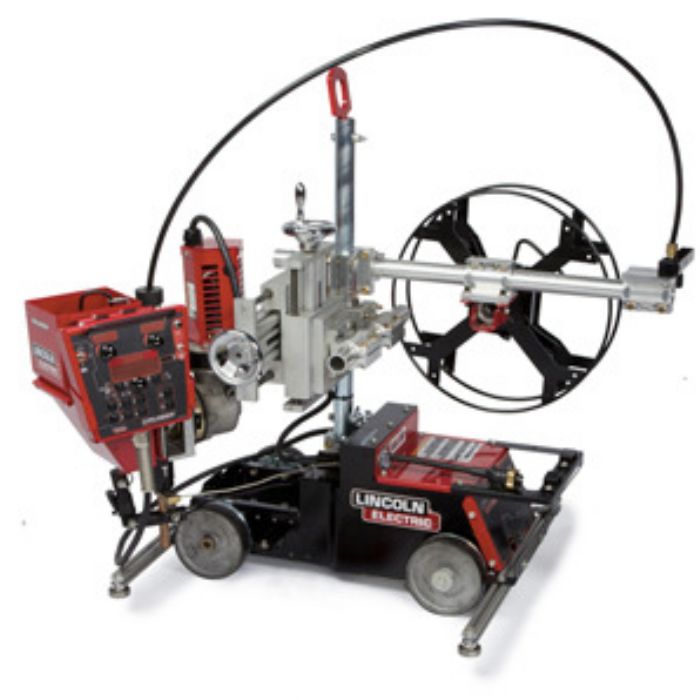 Gas-tungsten-arc welding (GTAW) establishes an electric arc between a nonconsumable tungsten electrode and the base metal. The arc zone, filled with an inert gas (typically argon), protects the tungsten and molten metal from oxidation and provides an easily ionized path for the arc current. The ability to be controlled at very low amperages makes GTAW ideally suited for welding on thin metal sheets and foils.
Gas-tungsten-arc welding (GTAW) establishes an electric arc between a nonconsumable tungsten electrode and the base metal. The arc zone, filled with an inert gas (typically argon), protects the tungsten and molten metal from oxidation and provides an easily ionized path for the arc current. The ability to be controlled at very low amperages makes GTAW ideally suited for welding on thin metal sheets and foils.
The biggest advantage of GTAW: It produces high-quality welds on almost any weldable metal or alloy. Another major advantage: Filler metal can be added to the weld pool independently of the arc current. In other arc welding processes, the rate of filler-metal addition controls the arc current. Other GTAW advantages include low spatter, no slag and relatively easy cleanup.
The slowest deposition rate of all the welding processes represents the main disadvantage of GTAW. The emphasis on making perfect-looking welds results in use of lower welding current and more welding time. And, the operator must learn to coordinate precise movements of the torch in one hand while adding filler metal with the other hand and controlling current with a foot pedal.
The operator also must learn how to properly set up a GTAW machine. Tungsten preparation, spark intensity, up-slope, downslope, pulsing rate, peak intensity, background current, high frequency and proper grounding present important issues when employing GTAW. Combined with lower deposition rates, it's easy to see how the GTAW process maintains quite a following in industries such as aerospace, where quality greatly trumps cost in importance.
SAW
Submerged-arc welding (SAW) uses a continuously fed wire with a flux to cover the weld area. This type of welding finds use primarily on heavier-plate applications such as structural steel and on specialized, high-speed welding of light sections.
The flux plays a central role in achieving high speed and quality welds. SAW produces little welding fume, leaving much cleaner shop air that other processes. Because flux covers the entire arc, SAW does not require a welding helmet, leading to a higher operating factor. In fact, on long, large welds, and on multipass and overlay applications, the process can approach a 100-percent operating factor, with welding currents exceeding 1000 A common on automatic applications.
Disadvantages include limited welding positions, because flux comes in granular form. Operators must weld on flat surfaces to assure that the flux covers the weld puddle. Another disadvantage: Hot flux can burn shoes and cause handling problems.
Find Your Right Power Source
This knowledge of the types of welding processes assists greatly in determining which process best meets a metal former’s needs. The next step: Start looking for a power source. The ideal power source should accommodate the desired welding process, meet size requirements, fit within the budget and offer the needed technology features. In the end, a reliable power source—like a reliable car—will continue to serve ably for many years to come. MF
Article provided by The Lincoln Electric Co., Cleveland, OH; 888/935-3877.
Industry-Related Terms: Alloys,
Case,
Electrodes,
Form,
Grinding,
Oxidation,
Shielding Gas,
Spatter,
Stainless Steel,
Surface,
Tungsten ElectrodeView Glossary of Metalforming Terms
See also: Lincoln Electric Co.
Technologies: Welding and Joining
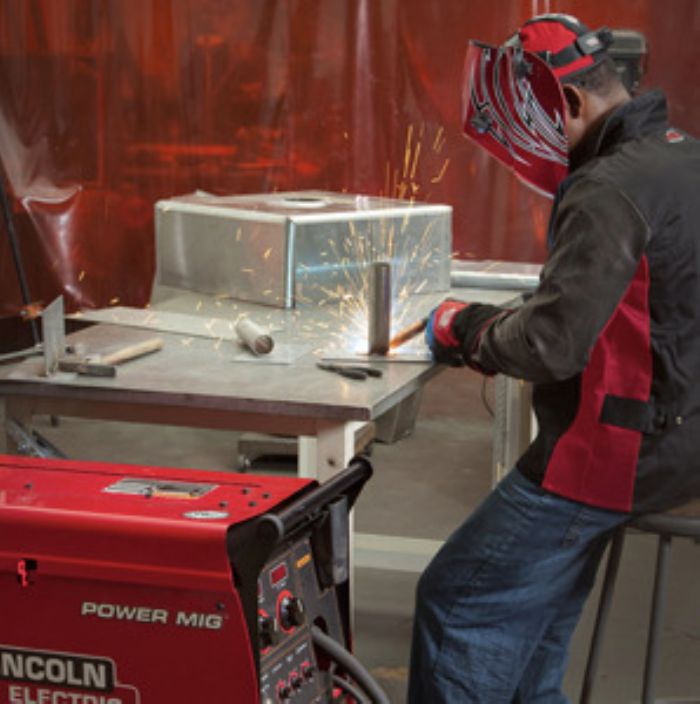 The first step: Understand the shop's internal needs. To determine these, examine some commonly used arc welding processes and the materials for which they are best suited.
The first step: Understand the shop's internal needs. To determine these, examine some commonly used arc welding processes and the materials for which they are best suited.





 GMAW and FCAW also offer higher welding speeds due to the continuously fed electrode, absence of slag in the case of GMAW and higher filler-metal deposition rates. With an operating factor―time where the welder actually “creates sparks”―of typically 30 to 50 percent, 3 to 5 min. out of every 10 min. can be spent creating an arc.
GMAW and FCAW also offer higher welding speeds due to the continuously fed electrode, absence of slag in the case of GMAW and higher filler-metal deposition rates. With an operating factor―time where the welder actually “creates sparks”―of typically 30 to 50 percent, 3 to 5 min. out of every 10 min. can be spent creating an arc.  Welders consider SMAW as one of the simplest and most versatile processes because filler material can be changed easily to match different metal alloys just by switching stick electrodes. Whether steel, stainless steel, cast iron or high-alloy metals, users simply clamp in a new rod to be ready for the next project. In addition, SMAW offers versatility because it requires the least amount of equipment, thus easing setup or relocation.
Welders consider SMAW as one of the simplest and most versatile processes because filler material can be changed easily to match different metal alloys just by switching stick electrodes. Whether steel, stainless steel, cast iron or high-alloy metals, users simply clamp in a new rod to be ready for the next project. In addition, SMAW offers versatility because it requires the least amount of equipment, thus easing setup or relocation. Gas-tungsten-arc welding (GTAW) establishes an electric arc between a nonconsumable tungsten electrode and the base metal. The arc zone, filled with an inert gas (typically argon), protects the tungsten and molten metal from oxidation and provides an easily ionized path for the arc current. The ability to be controlled at very low amperages makes GTAW ideally suited for welding on thin metal sheets and foils.
Gas-tungsten-arc welding (GTAW) establishes an electric arc between a nonconsumable tungsten electrode and the base metal. The arc zone, filled with an inert gas (typically argon), protects the tungsten and molten metal from oxidation and provides an easily ionized path for the arc current. The ability to be controlled at very low amperages makes GTAW ideally suited for welding on thin metal sheets and foils.